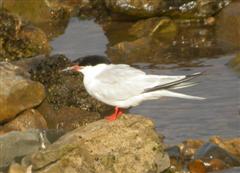Tern - Roseate
Graceful Tern Scientific Name: Sterna dougallii
Fri, 1st November, 2024 - 8:27 am GMT
Sponsor Ads:

Alternative Name
Graceful Tern Scientific Name: Sterna dougalliiBasic Info
The Roseate Tern is a beautiful species of wild bird. They have very long, distinctive beaks, perfectly adapted to grabbing fish from the water. They have little black patches on their heads and white underbellies and backs, and their wings are in general a grayish color. If it is breeding season, a small transformation will take place, and their legs and bills will turn a reddish color.
Health
Breeding The Roseate Tern can be found breeding in both Pacific and Atlantic oceans, as well as the Indian Ocean.Habitat
Usually found only along the coastlines of islands that have sandy or pebble beachesBehavior
The Roseate Tern is perhaps best known for its long, forked tail. These are beautiful seabirds that delight any bird watcher lucky enough to see one. Roseate Terns, also known as "Graceful Terns" are usually found only along the coastlines of islands that have sandy or pebble beaches. They are also seen in open grassy areas near the coastline. So adapted are these birds to their habitats that they are known to build their nests in the very driftwood that rests along the beach. In the wild Roseate Terns fly along the surface of the water to feed on small fish that come close to the top. Sadly the Roseate Tern is critically endangered. There are several key factors, which have lead to the decline of the Roseate Tern. Humans have been known to upset colonies of these birds, and they are also hunted by many natural predators, including rats, owls, falcons. Their numbers dwindle every year, and thus, several conservation groups are keeping a very close eye on the Roseate. They are relatively long-lived for a bird - they are suspected to live up to nine years in some cases. Overall, the Roseate is a rare bird that is fairly close to extinction. Hopefully, the conservation groups watching it can maintain its safety.Origin
North AmericaHistory
The Roseate Tern can generally be described as a tropical bird. They are seen breeding along the Pacific, Atlantic and India Oceans. Populations of these birds are seen in two distinct locations, the first is along the Caribbean Sea and the second is the coastal areas ranging from Nova Scotia to New York. Researchers still do not have much information on their wintering range.Common Foods
N/ASponsor Ads:
Turnaucka's Law: The attention span of a computer is only as long as it's electrical cord.
Tern - Roseate
Coded by: BGID® | ALL RIGHTS RESERVED Copyright © 2000-2024
Disclaimer | Privacy | Report Errors / Contact | Credits








 Homosexual behavior stems from the mind or genetics?
Homosexual behavior stems from the mind or genetics?  The Best Text Adventure You Will Ever Play! The official site:
The Best Text Adventure You Will Ever Play! The official site:  Why haven't we as a collective earth met with aliens yet?
Why haven't we as a collective earth met with aliens yet?  World EcoSystem - Biodiversity Changes - Who is on board and who isn
World EcoSystem - Biodiversity Changes - Who is on board and who isn  Mouthwash - Mouthrinse - Mouth Sores - Healing Infections - Gingivitis
Mouthwash - Mouthrinse - Mouth Sores - Healing Infections - Gingivitis  Treatment for Depression
Treatment for Depression  Ultra radical and violent Islamist group that even rivals Al Qaeda
Ultra radical and violent Islamist group that even rivals Al Qaeda  An idea to have teachers who want to carry guns to school undergo some level of police training will be left up to local school districts and police departments.
An idea to have teachers who want to carry guns to school undergo some level of police training will be left up to local school districts and police departments.